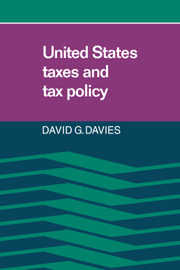Book contents
- Frontmatter
- Contents
- Preface
- 1 Economic foundations of U.S. tax policy
- 2 The individual income tax
- 3 Economic effects of individual income taxes and inflation
- 4 Expenditure versus income taxation
- 5 The taxation of capital gains
- 6 The corporation income tax
- 7 The corporation income tax and inflation
- 8 Social security payroll taxes
- 9 The value added tax
- 10 The sales tax
- 11 State taxes
- 12 Local government taxes
- 13 The distribution of tax burdens
- 14 Status of U.S. taxes and policy
- Appendix
- References
- Index
1 - Economic foundations of U.S. tax policy
Published online by Cambridge University Press: 05 May 2010
- Frontmatter
- Contents
- Preface
- 1 Economic foundations of U.S. tax policy
- 2 The individual income tax
- 3 Economic effects of individual income taxes and inflation
- 4 Expenditure versus income taxation
- 5 The taxation of capital gains
- 6 The corporation income tax
- 7 The corporation income tax and inflation
- 8 Social security payroll taxes
- 9 The value added tax
- 10 The sales tax
- 11 State taxes
- 12 Local government taxes
- 13 The distribution of tax burdens
- 14 Status of U.S. taxes and policy
- Appendix
- References
- Index
Summary
From the late 1930s until sometime in the 1970s, the exact date is too nebulous to pin down, the major influence on U.S. stabilization and tax policy was Keynesian aggregate theory. As we shall see in the forthcoming sections, Keynesian macrothought and policy has since been challenged by the monetarists, the rational expectationists, and the supply-siders.
Monetarists believe that appropriate control of the money supply will help foster the conditions necessary for the growth of a healthy economy. In the short run, changes in the stock of money are crucially important in determining fluctuations in real output and employment. In the long run, however, the quantity of money can only influence nominal gross national product (GNP). Real income is affected by many of the same elements that supply-side, neoclassical economists emphasize. These micro-economic factors include such real variables as the suppliers of labor, raw materials, and capital, the state of technology, the amount and quantity of human capital, the health and resourcefulness of individuals, a sound legal framework, and a stable and constructive public policy that contains the incentives necessary to put productive resources to efficient use (Meiselman 1982:9).
Monetary macromodels have not been especially successful in predicting the path and turning points of such important economic variables as consumption, investment, saving, and GNP. Moreover, the Federal Reserve has not followed the macrorecommendations of monetarists because it has been unwilling or unable to follow a consistent policy of steady growth in the stock of money.
- Type
- Chapter
- Information
- United States Taxes and Tax Policy , pp. 1 - 20Publisher: Cambridge University PressPrint publication year: 1986



